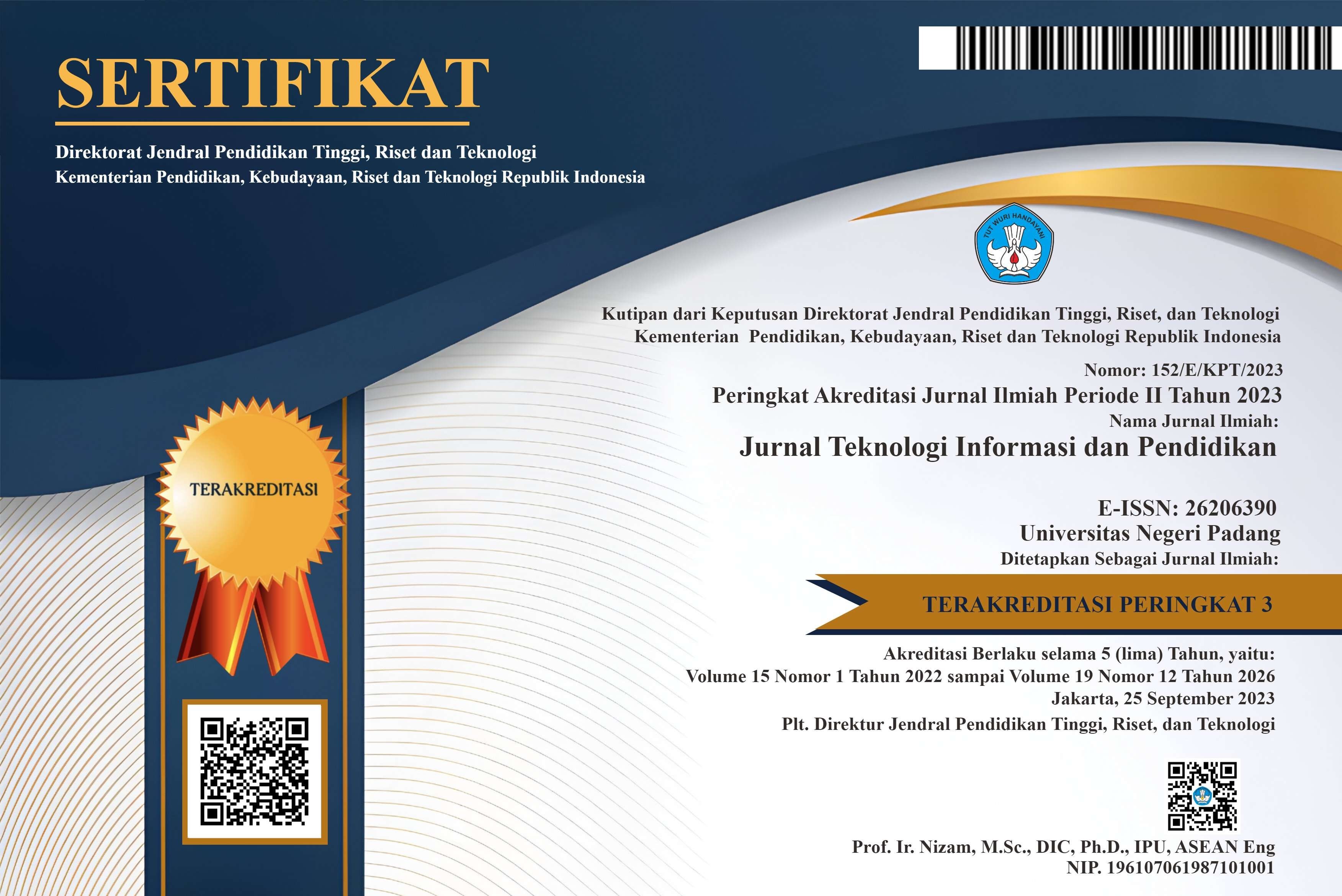Optimizing Classification Algorithms Using Soft Voting: A Case Study on Soil Fertility Dataset
Abstract
Classification algorithms are crucial in developing predictive models that identify and classify soil fertility levels based on relevant attributes. However, optimizing classification algorithms presents a major challenge in enhancing the accuracy and effectiveness of these models. Therefore, this research aims to optimize the classification algorithm in soil fertility analysis using ensemble learning techniques, specifically Soft Voting Ensemble. This research method is designed to understand soil fertility levels in modern agriculture by comparing the performance of various classification algorithms and ensemble approaches. Using a dataset from the Purwodadi Department of Agriculture, this study examines the optimization of algorithm parameters such as Random Forest, Gradient Boosting, and Support Vector Machine (SVM) and the implementation of Soft Voting Ensemble. Before applying Soft Voting Ensemble, each algorithm was evaluated with the following results: Random Forest achieved an accuracy of 90.93%, precision of 91.08%, recall of 90.33%, and F1-Score of 90.70%; Gradient Boosting achieved an accuracy of 91.53%, precision of 91.19%, recall of 91.56%, and F1-Score of 91.38%; SVM achieved an accuracy of 88.91%, precision of 89.66%, recall of 87.45%, and F1-Score of 88.54%. After implementing Soft Voting Ensemble, the accuracy improved to 91.63%, with an average precision of 91.21%, recall of 91.77%, and F1-Score of 91.49%. This study divided the data into 80% for training data and 20% for testing data. These findings indicate that the Soft Voting Ensemble has the potential to enhance agricultural productivity and sustainability.
References
A. A. Adenle, K. Wedig, and H. Azadi, “Sustainable agriculture and food security in Africa: The role of innovative technologies and international organizations,” Technol. Soc., vol. 58, no. 1, pp. 1–54, 2019, doi: 10.1016/j.techsoc.2019.05.007.
N. Khan, R. L. Ray, G. R. Sargani, M. Ihtisham, M. Khayyam, and S. Ismail, “Current progress and future prospects of agriculture technology: Gateway to sustainable agriculture,” Sustain., vol. 13, no. 9, pp. 1–31, 2021, doi: 10.3390/su13094883.
M. Bertola, A. Ferrarini, and G. Visioli, “Improvement of soil microbial diversity through sustainable agricultural practices and its evaluation by -omics approaches: A perspective for the environment, food quality and human safety,” Microorganisms, vol. 9, no. 7, pp. 1–22, 2021, doi: 10.3390/microorganisms9071400.
E. Z. Baskent, “A framework for characterizing and regulating ecosystem services in a management planning context,” Forests, vol. 11, no. 1, pp. 1–20, 2020, doi: 10.3390/f11010102.
M. Javaid, A. Haleem, I. H. Khan, and R. Suman, “Understanding the potential applications of Artificial Intelligence in Agriculture Sector,” Adv. Agrochem, vol. 2, no. 1, pp. 15–30, 2023, doi: 10.1016/j.aac.2022.10.001.
M. Javaid, A. Haleem, R. P. Singh, and R. Suman, “Enhancing smart farming through the applications of Agriculture 4.0 technologies,” Int. J. Intell. Networks, vol. 3, no. 7, pp. 150–164, 2022, doi: 10.1016/j.ijin.2022.09.004.
N. Khan, M. A. Kamaruddin, U. U. Sheikh, Y. Yusup, and M. P. Bakht, “Oil palm and machine learning: Reviewing one decade of ideas, innovations, applications, and gaps,” Agric., vol. 11, no. 9, pp. 1–26, 2021, doi: 10.3390/agriculture11090832.
M. S. Suchithra and M. L. Pai, “Improving the prediction accuracy of soil nutrient classification by optimizing extreme learning machine parameters,” Inf. Process. Agric., vol. 7, no. 1, pp. 72–82, 2020, doi: 10.1016/j.inpa.2019.05.003.
S. K. S. Durai and M. D. Shamili, “Smart farming using Machine Learning and Deep Learning techniques,” Decis. Anal. J., vol. 3, no. 3, pp. 1–30, 2022, doi: 10.1016/j.dajour.2022.100041.
X. Peng, X. Yu, Y. Luo, Y. Chang, C. Lu, and X. Chen, “Prediction Model of Greenhouse Tomato Yield Using Data Based on Different Soil Fertility Conditions,” Agronomy, vol. 13, no. 7, pp. 1–19, 2023, doi: 10.3390/agronomy13071892.
Y. Shahare et al., “A Comprehensive Analysis of Machine Learning-Based Assessment and Prediction of Soil Enzyme Activity,” Agric., vol. 13, no. 7, pp. 1–18, 2023, doi: 10.3390/agriculture13071323.
D. Ganesh, K. J. A. Yeshwanth, M. Satheesh, M. G. S. V. Reddy, T. Chirudeep, and S. N. K. Polisetty, “Extreme Learning Mechanism for Classification & Prediction of Soil Fertility index,” J. Pharm. Negat. Results, vol. 13, no. 6, pp. 37–43, 2022, doi: 10.47750/pnr.2022.13.S06.006.
Z. Aslam, N. Javaid, A. Ahmad, A. Ahmed, and S. M. Gulfam, “A combined deep learning and ensemble learning methodology to avoid electricity theft in smart grids,” Energies, vol. 13, no. 21, pp. 1–24, 2020, doi: 10.3390/en13215599.
M. Alipour and D. K. Harris, “Increasing the robustness of material-specific deep learning models for crack detection across different materials,” Eng. Struct., vol. 206, no. 2, pp. 1–14, 2020, doi: 10.1016/j.engstruct.2019.110157.
C. Chen and H. Liu, “Dynamic ensemble wind speed prediction model based on hybrid deep reinforcement learning,” Adv. Eng. Informatics, vol. 48, no. 4, pp. 1–15, 2021, doi: 10.1016/j.aei.2021.101290.
K. Lavanya, A. J. Obaid, I. S. Thaseen, K. Abhishek, K. Saboo, and R. Paturkar, “Terrain mapping of landsat8 images using mnf and classifying soil properties using ensemble modelling,” Int. J. Nonlinear Anal. Appl., vol. 11, no. 1, pp. 527–541, 2020, doi: 10.22075/IJNAA.2020.4750.
A. Gasmi, C. Gomez, A. Chehbouni, D. Dhiba, and M. El Gharous, “Using PRISMA Hyperspectral Satellite Imagery and GIS Approaches for Soil Fertility Mapping (FertiMap) in Northern Morocco,” Remote Sens., vol. 14, no. 16, pp. 1–22, 2022, doi: 10.3390/rs14164080.
K. Pragathi, “Crop Yield Prediction, Forecasting and Fertilizer Recommendation using Voting Based Ensemble Classifier,” Int. J. Innov. Res. Technol., vol. 8, no. 6, pp. 510–516, 2021, doi: 10.14445/23488387/ijcse-v7i5p101.
N. V. V. P. Mella and V. M. Pentakoti, “Crop yield prediction and Fertilizer Recommendation using Voting Based Ensemble Classifier,” J. Eng. Sci., vol. 13, no. 8, pp. 262–270, 2022, doi: 10.14445/23488387/ijcse-v7i5p101.
S. Karlos, G. Kostopoulos, and S. Kotsiantis, “A Soft-Voting Ensemble Based Co-Training Scheme Using Static Selection for Binary Classification Problems,” Algorithms, vol. 13, no. 1, pp. 1–19, 2020, [Online]. Available: https://doi.org/10.3390/a13010026
K. Pawlak and M. Kołodziejczak, “The role of agriculture in ensuring food security in developing countries: Considerations in the context of the problem of sustainable food production,” Sustain., vol. 12, no. 13, 2020, doi: 10.3390/su12135488.
X. Wang, “Managing Land Carrying Capacity: Key to Achieving Sustainable Production Systems for Food Security,” Land, vol. 11, no. 4, pp. 1–21, 2022, doi: 10.3390/land11040484.
G. T. Reddy et al., “An Ensemble based Machine Learning model for Diabetic Retinopathy Classification,” in International Conference on Emerging Trends in Information Technology and Engineering, ic-ETITE 2020, 2020, pp. 1–6. doi: 10.1109/ic-ETITE47903.2020.235.
N. Peppes, E. Daskalakis, T. Alexakis, E. Adamopoulou, and K. Demestichas, “Performance of machine learning-based multi-model voting ensemble methods for network threat detection in agriculture 4.0,” Sensors, vol. 21, no. 22, pp. 1–17, 2021, doi: 10.3390/s21227475.
A. Taha, “Intelligent ensemble learning approach for phishing website detection based on weighted soft voting,” Mathematics, vol. 9, no. 21, pp. 1–13, 2021, doi: 10.3390/math9212799.
L. Liu et al., “Deep neural network ensembles against deception: Ensemble diversity, accuracy and robustness,” Proceedings - 2019 IEEE 16th International Conference on Mobile Ad Hoc and Smart Systems, MASS 2019. pp. 274–282, 2019. doi: 10.1109/MASS.2019.00040.
A. Abbasi, A. R. Javed, C. Chakraborty, J. Nebhen, W. Zehra, and Z. Jalil, “ElStream: An Ensemble Learning Approach for Concept Drift Detection in Dynamic Social Big Data Stream Learning,” IEEE Access, vol. 9, no. 1, pp. 1–12, 2021, doi: 10.1109/ACCESS.2021.3076264.
G. Saxena, D. K. Verma, A. Paraye, A. Rajan, and A. Rawat, “Improved and robust deep learning agent for preliminary detection of diabetic retinopathy using public datasets,” Intell. Med., vol. 3–4, no. 1, pp. 1–11, 2020, doi: 10.1016/j.ibmed.2020.100022.
P. Srivastava, A. Shukla, and A. Bansal, “A comprehensive review on soil classification using deep learning and computer vision techniques,” Multimed. Tools Appl., vol. 80, no. 10, pp. 14887–14914, 2021, doi: 10.1007/s11042-021-10544-5.
O. Folorunso et al., “Exploring Machine Learning Models for Soil Nutrient Properties Prediction: A Systematic Review,” Big Data Cogn. Comput., vol. 7, no. 2, pp. 1–25, 2023, doi: 10.3390/bdcc7020113.
B. Charbuty and A. Abdulazeez, “Classification Based on Decision Tree Algorithm for Machine Learning,” J. Appl. Sci. Technol. Trends, vol. 2, no. 1, pp. 20–28, 2021, doi: 10.38094/jastt20165.
F. Rustam, M. Khalid, W. Aslam, V. Rupapara, A. Mehmood, and G. S. Choi, “A performance comparison of supervised machine learning models for Covid-19 tweets sentiment analysis,” PLoS One, vol. 16, no. 2, pp. 1–23, 2021, doi: 10.1371/journal.pone.0245909.
Copyright (c) 2023 Jurnal Teknologi Informasi dan Pendidikan

This work is licensed under a Creative Commons Attribution-ShareAlike 4.0 International License.















.png)














